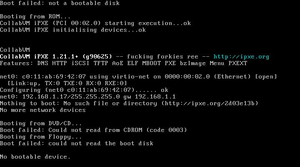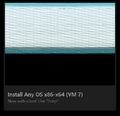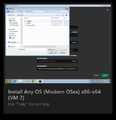VM7 (Install Any OS (Modern OSes) x86-x64)
VM7 is a VM that debuted in December 2021. The VM allows any user to install any OS they want, either through Lily or Dartz's ISO folder or from a website using !httpcd (url). A list of them can be found at http://computernewb.com/~dartz/isos and http://computernewb.com/~lily/ISOs.
There is also an alternate version of VM7 for older operating systems you can use, called VM8. You can view the article for it here.
Users interact with the VM through a bot named AnyOSInstallBot. Another way users can interact with the VM is the default iPXE which is named "CollabVM iPXE", a custom version of iPXE. This iPXE version behaves similar to vanilla iPXE, VM8 does not have this however.

Facts about VM7
- Forkies usually come on VM7 to eject the CD and install some other OS over the one you were attempting to install or type !reboot and !eject cd in the middle of an install when you are using the system.
- Due to the TPM 2.0 requirements of Windows 11 (and the fact that VM7 does not have a vTPM), and also annoying children trying to install it, attempting to insert the ISO will insert "Windows 7 Haunted Edition" instead
- AnyOSInstallBot may not be present sometimes due to it being offline or an admin kicking it (likely due to abuse of the bot)
Tips for both VM7 and VM8
- People enjoy installing operating systems that are already their own VMs. Instead of doing that, try installing some really obscure OS or a bootleg from Crustywindows.
- If you don't want to wait so long for
!reboot, you can alternatively open the webapp OSK and soft reboot the virtual machine by pressing Ctrl+Alt+Delete.
- When booting, go to iPXE command line and type in
exit, this way you don't have to wait for iPXE to tell you that there is no network devices then let you boot to CD or floppy faster.
- The best bootset order is
nad. Why? Not because that's slang for testicles, but because by using the sanboot command in iPXE, you can still boot to the hard drive by typing insanboot -d 0x80.
- Actually, the best bootset order depends on how you are going to install something on VM7. You can do
dcif you're going to insert a CD to install an OS, and then eject it later and boot to the OS faster.
Gallery
-
People installing a post-reset Vista build (and failing, as you can see)
-
Windows CHOCOLATEMAN Edition running on VM7
-
VM8 when restored from the snapshot. Notice how it does not have "CollabVM iPXE"
-
People installing Windows XP Professional on VM8
OS Compatibility Reference Sheet for VM7
OSes confirmed to work on VM7
- Windows 2000 to 11 - Older than 2000 works but no networking
- Any GNU/Linux distribution with VirtIO modules built in
- Any Windows 2000 to 11 bootleg from Crustywindows
- OpenBSD
- DragonFlyBSD
- NetBSD
- GhostBSD - utouch-kmod is required for absolute mouse input.
- OmniTribblix
- OpenIndiana
- 9front
OSes that do not work on VM7
Doesn't work at all
- FreeBSD - 64-bit panicks due to something with APIC and 32-bit gets stuck on "Timecounters tick every 10.000 msec"



